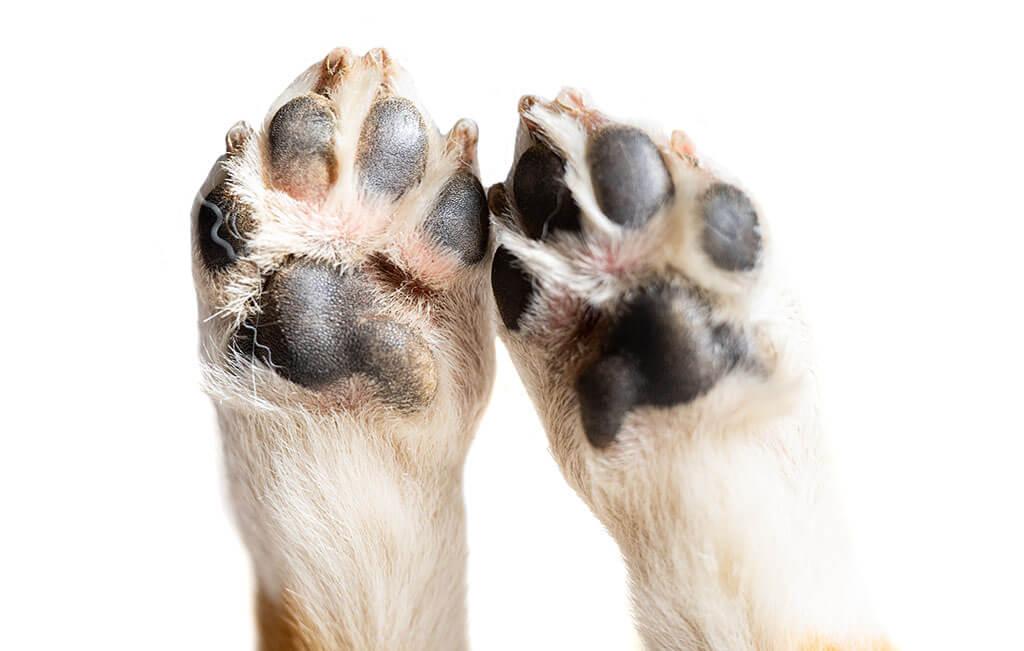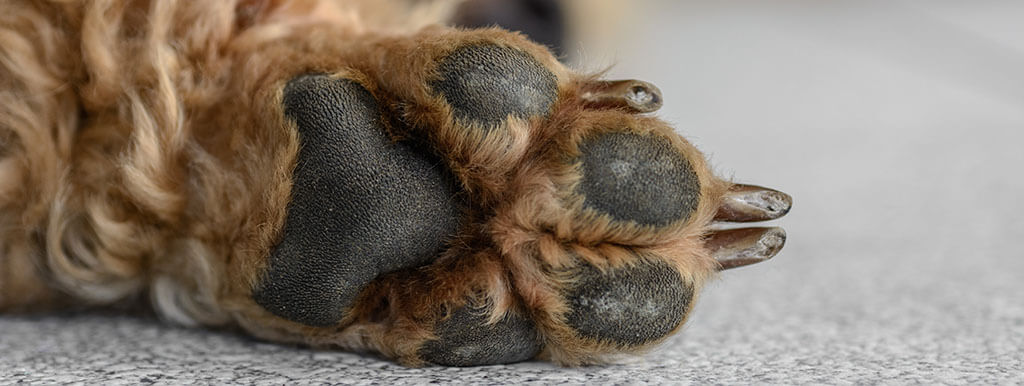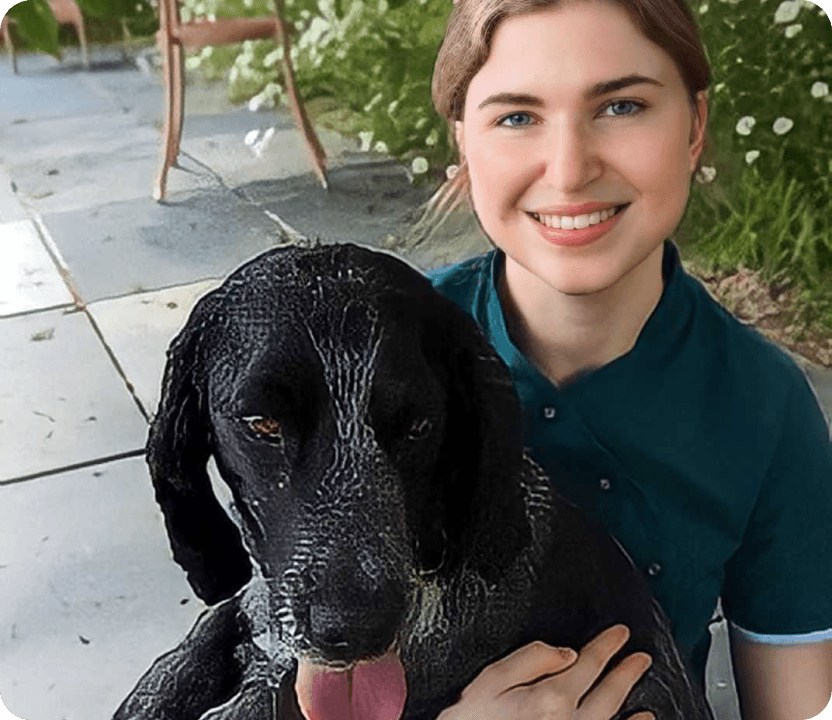Explore the complexities of dog paw hyperkeratosis in our in-depth article. With a focus on both prevention and treatment, our experts outline strategies to manage this chronic condition, ensuring your dog remains comfortable and infection-free.
- Home/
- Dog/
- Health & Wellness/
- What Is Dog Paw Hyperkeratosis and How to Manage It
What Is Dog Paw Hyperkeratosis and How to Manage It

Are your dog’s paw pads thickened, crusty, or even ‘hairy’? If so, you’re not alone. Dog paw hyperkeratosis is a relatively common condition, especially in middle-aged and older dogs. For many dogs, there’s no obvious cause, so the aim of treatment is to manage this chronic condition. However, in some cases, hyperkeratosis of dogs’ paws can indicate a more severe underlying disease.
This article reviews the symptoms and causes of dog paw hyperkeratosis, and how you can manage it.
Key facts:
- Paw pad hyperkeratosis is relatively common in older dogs.
- It often occurs without a specific cause in older dogs but can also be the result of an inherited condition, infection, autoimmune disease, or other illness.
- The overly-thickened keratin layer can crack and fissure, causing pain and allowing secondary infections to take hold.
- There’s no cure for most cases, but with the right management, it shouldn’t prevent your dog from living a long and happy life.
What is dog paw hyperkeratosis?
Dogs’ skin, like humans, is made up of layers of cells with an outer layer of keratin. Keratin is a protein that helps to protect the underlying cells – it’s vital for healthy skin. The keratin layer can naturally thicken in response to pressure or friction, forming calluses on your feet, for example.
However, if this keratin layer becomes excessively thickened, it can change the appearance of the skin and start to cause problems. This condition can affect any area of the skin, causing crusting and scaling. In this article, we’re focusing on conditions that affect the paws.
What are the clinical signs?
Dog paw hyperkeratosis can cause the surface of the pads to become thickened and crusty, but their appearance is often described as haired or ‘feathered’. The keratin can form fronds as it develops, giving the paws this misleadingly soft appearance.
If untreated, hyperkeratosis can cause discomfort, development of corns, and even lameness.
As the condition worsens, small cracks or fissures may also develop. These can allow secondary infections which cause inflammation and pain.

Causes of dog paw hyperkeratosis
Aging
For many dogs, paw hyperkeratosis is idiopathic, which means it occurs without a known cause. This is usually associated with aging, being seen in middle-aged and older dogs.
This type of paw pad hyperkeratosis is often found alongside hyperkeratosis of the nose (nasal planum), which has a similar appearance.
It’s been suggested that this ‘idiopathic nasodigital hyperkeratosis’ is more common in brachycephalic breeds and cocker spaniels, but it can affect any dog. Friction from harsh, abrasive surfaces or chronic inflammation may also contribute.
Although there’s no cure for this type of age-related ailment, the good news is that it’s usually relatively benign. However, it’s important to manage this condition to prevent it from worsening and resulting in pain and secondary infections.
Inherited disorders
Various breed-related genetic disorders can cause hyperkeratosis of the paws. These include familial paw pad hyperkeratosis and nasal parakeratosis. Predisposed breeds include the Dogue de Bordeaux, Golden Retriever, Irish Terrier, Kerry Blue Terrier, and Labrador Retriever. Inherited hyperkeratosis usually begins to develop at a young age, with symptoms often appearing in the first few years of life.

Infections and parasites
It’s uncommon for hyperkeratosis to be caused by infection or parasites, but it is possible.
Severe hyperkeratosis of the nose and footpads is one of the classic symptoms of Canine Distemper Virus. This infection causes a range of severe symptoms and is often fatal – so if hyperkeratosis of your dog’s pads is your main concern, it’s unlikely to be the cause. Fortunately, vaccination against Canine Distemper Virus is usually included in your dog’s routine vaccinations and is very effective.
Leishmania is a blood-borne disease transmitted by sandfly bites. It’s most common in South America and southern Europe, so affected dogs often have a history of travel to these areas. This disease can take anywhere from 1 month to several years for symptoms to develop. When they do, they’re often severe, ranging from fever, weight loss, diarrhea, and vomiting to neurological symptoms and even joint and muscle disease. Around 90% of affected dogs also show skin-related symptoms; paw pad and nasal hyperkeratosis are common.
Other infections that may contribute to hyperkeratosis include dermatophytosis (fungal infection; ringworm) which can cause scaly, crusty skin to develop. However, this usually won’t be limited to just the paw pads and will affect other areas of skin also. Rarely, parasites such as hookworms have been linked to hyperkeratosis.
Zinc-responsive dermatitis
This is an uncommon cause of skin disease, affecting dogs of any age. Breeds including the Husky, Malamute, and Samoyed are predisposed, as are young, rapidly growing large-breed puppies. A lack of zinc (due to either reduced absorption or a zinc-deficient diet) affects the skin, causing crusting and scaling at various sites, including the paw pads.
Autoimmune disease
Autoimmune diseases are relatively rare; however, the most common autoimmune disease to cause hyperkeratosis is pemphigus foliaceous. In addition to hyperkeratosis of the pads, ulceration, crusting, and scaling of the skin on the head and ears are also usually seen.
Other causes
Various rare causes of hyperkeratosis exist, including some forms of cancer and hepatocutaneous syndrome, a severe skin condition associated with systemic disease that usually causes inflammation and ulceration in addition to hyperkeratosis.
Diagnosing dog paw hyperkeratosis
Paw pad hyperkeratosis, either alone or with nasal hyperkeratosis, is often diagnosed on the basis of a clinical examination and history. If there are signs of inflammation, infection, or other symptoms such as itching, your veterinarian may recommend additional testing. This often includes taking a superficial skin scrape to assess under a microscope. Further testing may include a fungal culture and a biopsy of the affected area to obtain a definitive diagnosis.

How to treat hyperkeratosis on dogs’ paws
This condition can’t usually be cured, but there are things you can do to manage and keep it under control.
- Treat underlying disease: hyperkeratosis due to infections, autoimmune disease, or zinc deficiencies can be treated and resolved over time.
- Trim excess keratin: in severe cases, it may be best to trim back excess keratin, usually after softening it by soaking it in warm water. This is best performed by your veterinarian, but if you want to try it at home, seek veterinary advice first.
- Warm water soaks: soaking your dog’s paws in warm water with Epsom salts for 10 minutes can help to hydrate and soften the pads.
- Apply ointment or balm: regular application of dog-safe moisturizing products can help keep your dog’s paws supple and soft, minimizing the impact of hyperkeratosis.
- Keep paws clean and dry: hyperkeratosis increases your dog’s chances of developing infections, so the paws should be kept clean and dried thoroughly to minimize this risk.
- Consider boots: some dogs are more comfortable wearing boots to walk on hard surfaces.
- Monitor for pain or infection: if you notice redness, licking, or lameness, see a veterinarian quickly to minimize the impact of any secondary problems.
- Use medication if needed: if your dog develops an infection, they may need antibiotic or antifungal treatments from your veterinarian.
Final words on dog paw hyperkeratosis
Dog paw hyperkeratosis may look concerning, but for most dogs, once it’s controlled, it’s primarily a cosmetic concern. If left unmanaged, it can progress and cause pain and secondary infections – so the key points are to seek veterinary advice, trim away any substantial excess keratin (i.e., the “keratin feathers”), keep the paws hydrated, and monitor for any other symptoms like itching, inflammation, and redness. If underlying diseases have been ruled out and the condition is under control, most dogs will live long and happy lives without any significant hyperkeratosis-related issues.
Paw hyperkeratosis FAQs
Can I use Vaseline on my dog’s paws?
While you can use Vaseline to moisturize your dog’s pads, it’s not the best product for this. If your dog licks their paws and ingests a significant amount, it can cause an upset stomach. It may also absorb into the paw less than other products, resulting in more mess. Dog-safe balms and creams are typically the best option.
How do I know if my dog has an underlying condition?
Most dogs with paw pad hyperkeratosis don’t have an underlying health issue. Those that do typically show other symptoms such as inflammation and ulceration, changes to the rest of their skin, or signs of systemic illness.
Sources:
Jackson, H., & Marsella, R. (Eds.). (2012). BSAVA Manual of Canine and Feline Dermatology (3rd ed.). British Small Animal Veterinary Association. https://www.veterinary-practice.com/article/idiopathic-nasodigital-hyperkeratosis
Tilley, L.P. et al. (2021) Blackwell’s five-minute veterinary consult. Hoboken, NJ: Wiley-Blackwell, John Wiley & Sons, Inc. https://www.vettimes.co.uk/app/uploads/wp-post-to-pdf-enhanced-cache/1/zinc-responsive-dermatosis.pdf
 P
P





